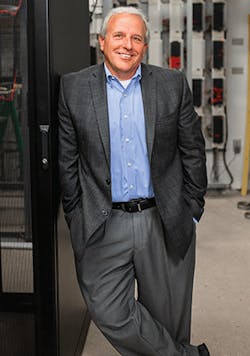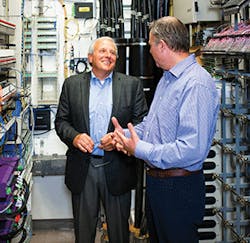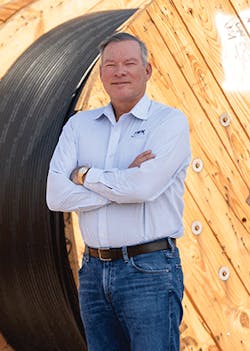Executive Insights With 2 Fiber-Forward Providers
Learn what William S. Helmly, Home Telecom’s President and CEO, has to say about RDOF, Edge Compute, and leading a family-based business in telecom.
Robert and Dozier Helmly began managing Home Telephone Company in 1962. At that time, the vision was: To provide Home Telephone customers with service on par with that of global telecommunications companies while maintaining the company’s reputation for local investment, leadership and service. Today, you are running Home Telecom. Here are 2 questions related to that history.
ISE: Family business can be tricky, to say the least. What are your greatest learnings from this journey?
Will: The family business actually goes back several generations. My Great Grandmother was the first switchboard operator who ended up purchasing the company. My grandparents ran it before my father took over the reins. The bar set by my father and uncle was high. The biggest family-related item I have learned is to hold family to the same level of accountability as any other employee. Equally, strive to treat employees like family. None of it is easy, and can make for some awkward Thanksgiving dinners. But it does create a special culture where everyone feels connected.
ISE: How has your mission evolved, and what concrete network realities have challenged that mission?
Will: We have kept our core mission to globally connect our communities, but we have added in another key piece to the puzzle: easy to do business with. Both of these are very important to our goals and our relationships with our customers. The complexities of our fast-changing, constantly evolving technology business are always challenging us to stay easy-to-do-business-with. Offering a variety of solutions in a simple, easy-to-use manner is not always achievable when the components of those solutions are constantly changing. Sometimes the latest, greatest widget that everyone wants only works with one vendor or software product — therefore, having an integrated, easy-to-use customer interface cannot be accomplished.
Topic: HOME TELECOM’S FTTP NETWORK
ISE: As of early spring, you provided 47% of your customers with your advanced Fiber-to-the-Premises (FTTP) infrastructure with speeds up to 1 Gig. What’s the plan to light up 100% of your customers with fiber? (Heck, Google can’t seem to do it, so you must have some best practices.)
Will: Actually, we now have over 62% of our customers on FTTP. Lighting up 100% of our footprint with Fiber is definitely our long-term goal. However, we do still serve some very rural markets directly and have neighboring rural markets that are unserved. Home Telecom has an evolving plan that involves overbuilding our current copper plant and expanding into areas we have never served before. The financial realities of providing FTTP to these areas make buildout without some financial support very difficult. In addition to investing our own capital, Home Telecom has been happy to invest the manpower in discovering and applying for federal, state and local matching grants that could expedite our efforts.
Topic: RDOF
ISE: In early January 2021, the Federal Communications Commission (FCC) announced its new Rural Digital Opportunity Fund (RDOF) for faster broadband speeds to help close The Digital Divide in rural areas. Over the next 10 years, RDOF will push out up to $20.4 billion in funding to build and connect gigabit broadband speeds in unserved rural areas. What are the best network deployment strategies providers should embrace to deliver on their commitment after receiving these funds?
Will: RDOF is kind of a sore subject as I believe the process was badly implemented. Instead of taking this opportunity to ensure providers build advanced, future-proof networks, the process was hijacked by speculative technologies or providers with alternative motives. There were no meaningful penalties put in place for providers who do not buildout with advanced networks within a reasonable timeline.
However, we were fortunate to receive funds from the ReConnect Grant. With the additional funds received from the ReConnect Grant, we are able to plan out a 5-year buildout plan to residents who have access to very low DSL speeds, if they are lucky to have Internet access at all. We have projected to complete this in 2 years.
Regarding best practices after receiving funds like these, we recommend to first quickly get the management team together to develop the buildout plan with aggressive goals.
Second, spend time with the necessary agencies early so permits and paperwork are not a hindrance.
The COVID-19 pandemic taught us that Internet connectivity is crucial and essential. In terms of working from home, being able to attend classes remotely, and even accessing telemedicine, there is no substitute for a dependable, strong Internet connection.
Topic: PAIN POINTS
ISE: What are 2 of your company’s biggest network-related challenges right now?
Will: One challenge is the rapid growth of our network. The movement of data is driving further consumption needs of our customer base. We meet this challenge by implementing FTTx solutions along with unmatched speeds using cutting edge technologies to our end users. Staying on top of the cutting edge technology to make sure it meets our customers’ needs is also a welcome challenge.
A second challenge these days is related to supply chain related issues. Across the country, providers are investing heavily in their networks. The addition of support funds on the current scale (Reconnect 1 & 2, RDOF, Cares Act, American Recovery Act, State governments), along with the impending Federal Infrastructure investment, has made the demand side go through the roof.
In addition, many supply chains have not yet fully recovered from COVID-19-pandemic-related disruptions. In fact, purchasing service vehicles is a challenge right now due to the chip shortage.
Topic: COST EFFICIENCIES
ISE: In a recessionary environment, conservative cash management is imperative. How has your team created cost efficiencies? Please elaborate.
Will: Cost efficiencies are an important aspect of our business.
- We pride ourselves on our ability to identify ways to create efficiencies through automation and leverage technology to interface with our customers and employees.
- We have a wide array of products that we use today to support customers from self-service portals to customized applications.
- Our employees have the ability to implement, manage, and maintain, customers’ equipment and services from anywhere by utilizing industry-leading applications.
All of this saves valuable time, which in turn creates savings.
Currently, we are investing heavily in our internal processes and our internal IT department to not only create efficiencies, but to reduce unnecessary burden with our customer interactions. Annually, we host "Spot the Opp" incentives within the company to encourage our employees to get involved in finding opportunities for improvement on a company-wide level.
InvisiLight® Solution for Deploying Fiber
April 2, 2022Go to Market Faster. Speed up Network Deployment
April 2, 2022Episode 10: Fiber Optic Closure Specs Explained…
April 1, 2022Food for Thought from Our 2022 ICT Visionaries
April 1, 2022Topic: TECHNICIANS = THE FACE OF THE BRAND
ISE: Talk about the importance of your field technicians. What are you doing to help them improve both their hard and soft skills so they can make a positive impact as the FACE of your company to your end users?
Will: Our field technicians are some of the best technicians you will ever meet. We receive compliments daily about their work ethic, product knowledge, patience, and pleasant manners. For our customer-facing employees, we have a fairly rigorous onboarding process where we spend quite a bit of time to make certain they understand our culture so they can practice that culture in every interaction.
Our management supports Quarterly Personnel Training led by our Marketing Department for ongoing training for all customer-facing employees. The training session reviews new products, pricing, communication methods, and more. Employees have a chance in every session to provide feedback about what they are hearing from customers and ask questions.
Topic: 5G — IT’S ALL ABOUT FIBER
ISE: 5G not only enables transformative new services (the Internet of Things, connected cars, telehealth, and precision agriculture), it creates economic productivity and jobs. But the future of wireless is inextricably linked to our ability to deploy fiber infrastructure across the country. If we want to bring economic productivity and jobs, we need to scale fiber and deploy more fiber to everyone. What are some creative solutions Home Telecom is employing to helping FTTx-to-Everywhere efforts?
Will: As one of the first FTTx providers in South Carolina, Home Telecom recognizes the value of leveraging fiber to its highest capabilities. We often joke that we think we were the first to deploy Fiber-to-the-Septic-Tank when one of our earliest deployments needed a fiber connection to enable an alarm on their septic system.
We stay on the cutting edge of technology to provide the highest bandwidth speeds to our customers as possible. Our valued partnerships with other utility partners are just one of the ways we accomplish this. They see us as their fiber solution and we are the first call they make when they need advanced connectivity. Whether it is connecting all of the sub-stations for the local electric cooperative, connecting cameras for local law enforcement, or helping water and sewer monitor their systems, we want them to think of us as their solutions provider.
This relationship applies to the less technical side as well. Our engineers and field crews are working with other local utilities to jointly build infrastructure when it makes sense — from joint trenching to simply helping each other when on a tight deadline or challenging situation.
(https://www.ey.com/en_us/consulting/six-habits-of-digital-transformation-leaders)
Will: I think the 2 traits that I look for most, and can be hard to find, is being a critical thinker and the lifelong desire to learn. Look for opportunities to improve yourself, the systems you use to complete your work, and the people around you. Be curious! In every problem, look not only for the immediate fix but also ask What can be done to prevent this issue from coming up again?
Topic: $$$ FOR SATELLITE DEPLOYMENTS
The Rural Digital Opportunity Fund (RDOF) is an FCC initiative designed to inject billions of dollars into the construction and operation of rural broadband networks. It recently awarded SpaceX (and its Starlink product) $885 million in its Phase 1 auction. (Phase 1 RDOF allocated $9.2 billion; Phase 2 auction will allocate $11.2 billion.) SpaceX has committed to use the money to bring its satellite service to 642K rural homes and businesses across 35 states with its fleet of about 700 low-Earth orbit (LEO) satellites.
Amazon’s Project Kuiper plans to invest $10 billion to deploy 3,236 LEO satellites and deliver satellite-based broadband across the US. It aims to provide backhaul for wireless carriers, and to help bring LTE and 5G services to new regions in the US.
ISE: Share your thoughts about how this impacts the competitive landscape, and how it helps bridge The Digital Divide in the near future.
Will: As I mentioned earlier, this is one of my biggest disappointments with the RDOF process. I feel the FCC missed a golden opportunity to invest in proven, longer term solutions. Even Starlink said that their solution is best categorized as "better than nothing." And that is only if it actually delivers on its promise since it is a completely unproven technology. It seems to me that "better than nothing" is a very low bar and the nation would have been far better served by investing long term money into long term, proven technology solutions.
Topic: NETDEV OPS AND EDGE COMPUTING
ISE: 5G requires edge computing, which brings content or data processing capability closer to the end user or data source so that an instantaneous, real-time response can be delivered. Virtualization makes this possible, and virtualization is a practice which sits in the domain of DevOps. By adopting cloud native architecture, telcos can move services towards the edge of the network to provide the required latency and throughput. Share your thoughts about this and Home Telecom’s road map in this area.
Will: Given the rapid network topology transitions that have become second nature to us, we are well-positioned with the ability to scale our existing solutions. For instance, our experience with using caching servers is a way to provide faster throughput and less latency. This ensures a better overall user experience for our customers who are trying to access some of their favorite sites or applications.
As the Edge keeps getting pushed closer and closer to the customer, we continue to invest in the physical infrastructure and core network while also investing in virtualization, automation, and AN where it makes sense. This provides for a network and an experienced team that can support whatever the demands that the future networks require.
Topic: OVERLOOKED ISSUES
ISE: What should all of us in the Information and Communication Technology industry be talking about that we are not? Or what current topic is the most important that needs additional and different attention?
Will: While I am a proponent of light regulations, I am very concerned by the prevalence of what is currently categorized as Big Tech and their amount of control in our daily lives. Being a pure network service provider, it is scary how easily control of the content (traditional linear content, OTT, or social media) was consolidated into a few Big Tech companies. Companies who are now teaming up almost exclusively with the biggest, multi-national service providers. "Sign up for multi-national service provider X and you get Big Tech Company Y’s content for free." As a smaller provider, we are shut out of these conversations. Even when all smaller providers team up, there is still not enough market represented to get Big Tech’s attention.
Topic: SKILLS GAP
ISE: According to a recent survey by EY, 59% of companies believe there’s an industry-wide shortage of the type of skills that would help accelerate their digital transformation efforts. Share what you are doing for your team members to ensure you are helping close this gap.
Will: I would have to say that the Millennial generation has a pretty bad reputation and much of that is well-earned. However, we have been able to grow our workforce by over 20% and still growing. We stick firmly to our corporate culture standards while embracing a very diverse workforce. We invest heavily in all forms of workforce development and even started a formal apprenticeship program for our higher end network positions. Back to those Millennials, we have learned that they are some of the fastest learners, are not intimidated with technology, are very analytical and enjoy diving deep into the data. In fact, we have to ensure their work is plentiful and challenging to keep them from getting bored.
Topic: LISTENING
ISE: Is there a favorite podcast you listen to regularly? Please share one nugget of wisdom you’ve gained from it.
Will: There is a saying: Leaders Are Readers. In today’s world, I believe you would have to include podcasts as a form of reading. Someone also told me a long time ago that God gave you 2 ears and 1 mouth so you should spend twice as much time listening and learning as you do talking or instructing. That has always served me well.
Topic: ENERGY
ISE: If energy were free, what would your team do differently? (We’re not talking about battery or back-up power. We’re referencing the power of time and mind-share.)
(Source: Tony Hsieh, CEO of Zappos, via http://www.inc.com)
Will: I think everyone on my leadership team would probably agree that we should spend more time looking further down the road. While we do spend considerable energy on long-range planning, the daily urgent demands often cause us to react in ways that are sometimes counterproductive to these long-term goals.
Topic: COVID-19: A YEAR+ LATER
ISE: If necessity is the mother of invention, what new, successful things are you doing now that have been born from the learning you’ve acquired over the last year+?
Will: It has certainly been a year to remember! When the Coronavirus-19 pandemic broke out across the country, we handled it the same way Home Telecom handles all crises:
- We came together as a team to assess the needs of our community.
- We brainstormed solutions, prioritized the rollout of those solutions, set goals for accomplishing them, and remained focused while we implemented the plans.
- We constantly reassessed our strategies throughout — and we learned so much along the way.
We learned that the more tools customers have access to in order to control their services on their own, the better. The majority of our customers like using our Live Chat feature, paying their bills online, and receiving emails with tutorials from our representatives. We also learned that even though social distancing and wearing masks were of the utmost importance, customers still wanted our technicians in their homes. They craved the familiar contact only a local company can provide. While we did implement many CDC guidelines for employee interaction, we never slowed our work pace and in fact had a record year in terms of both new customer growth and upgraded services to existing customers.
Topic: CONNECTING THE UNDERSERVED FOR REMOTE LEARNING
ISE: According to a recent survey conducted by Digital Wish, 19% of students do not have Internet connectivity at home, and over 21% do not have access to a computing device, impacting their ability to adequately participate in remote learning. Share what new tools in the toolbox Home Telecom is using to reach/connect the underserved?
(Source: https://www.digitalwish.com/dw/digitalwish/home)
Will: From the beginning of the pandemic, we spent countless hours working with local school districts to identify students’ residences that did not have Internet access and expanding our network where it was possible. As with many things, the price of Internet is sometimes a luxury that many households cannot afford. To combat that, we offer a Community Connect program that offers up to 25 Mbps Internet with Wi-Fi to qualifying homes for only $9.95 per month. When the pandemic lockdown began in March of 2020, we introduced a temporary free Internet offer to students so they could continue learning from home. We waived the installation fee and were blown away by the response we received. We were fortunate that we could be in a position to offer that to so many homes that needed it.
Topic: SUPPLY CHAIN
ISE: In what ways has Home Telecom been challenged by supply chain issues? Are there suggestions you have for the vendor community to help remedy these challenges?
Will: Supply chain issues have been a real challenge for us over the past year. Many factories had to limit the amount of employees working at a time, which affected their productivity, and ultimately affected our inventory levels. There are times when we had to stop advertising certain products due to lead times for deliveries being so far out. We have also had to reach out to other companies to see if we could purchase their surplus inventory (if they were fortunate to have any) and investigate refurbished options.
I would encourage vendors to communicate often with their telecommunications partners and be honest about delivery times. It’s so important for us to know right away when an order will be delayed by weeks or even months. There were times when we were promised (repeatedly) that we would have inventory on day X, only to find out after day X that delivery was delayed by additional weeks. We can then be proactive in looking for a temporary solution instead of taking a reactionary stance. That is not good for our company or our customers.
Topic: CUSTOMER CARE
ISE: Companies that prioritize innovation and care in redesigning customer experiences will be best positioned to stay ahead of shifting consumer preferences. What 2 customer-centric tactics that Home Telecom does extremely well do you recommend to other providers?
Will: Ease and consistency are the cornerstones of our innovation efforts when we provide customer care tactics. We want to bring something to the customer that solves a problem for them, is easy to use, and is reliable above all else.
Topic: HONESTY
ISE: What is it like to work for you?
(Source: Robert Sutton, author and management professor at Stanford, via https://www.inc.com/)
Will: I am actually a pretty simple person. Do your job to the high standards we have set, without a lot of drama or excuses, and life is good. In the past, we called it a "customer first" mentality with your specific customer sometimes being the employees in the next office. When everyone supports their customer to the high standards we set, the entire machine runs much better.
Topic: TEAM MEMBERS
ISE: Among your stronger employees, how many see themselves at the company in 3 years? How many would leave for a 10% raise from another company?
(Source: Jonathan Rosenberg, adviser to Google management, via https://www.inc.com/)
Will: We always say we hire only employees that we expect to retire from here. We want employees that fully buy in to our culture and our vision here. That is not always the reality but it is our mindset. While the unemployment rate is among the lowest in the nation, here, we have very little voluntary turnover. I would guess that we would have less than 5% that would be expecting to leave in the next 3 years, and even less among the veteran employees. When employees opt to leave, it is usually either for a significantly better position or a change in their personal situation.
Topic: LONGEVITY
ISE: What is something you’d be happy doing every day for the rest of your career?
Will: I enjoy helping others succeed. One of my biggest pet peeves is seeing unrealized potential. I would be happiest if I could spend more time helping others, or myself for that matter, realize more of their unrealized potential.
Topic: IN PURSUIT OF KNOWLEDGE
ISE: What’s the best book you’ve read this year that others can learn from?
Will: I recommend the book Upstream: The Quest to Solve Problems Before They Happen by Dan Heath. We have been sharing this book around the company this year. He provides a pretty concise set of tools to help prompt more of the critical thinking I mentioned previously.
William "Will" S. Helmly was appointed as President and CEO of Home Telecom in November 2017. Will has served Home Telecom in a variety of capacities since joining Home Telecom in 1992, including VP of Engineering and Executive VP. Will takes an active stance in the community by serving on local and state boards. He is a 1986 graduate of the University of South Carolina with a Bachelor of Science degree in Electrical Engineering. You can follow Will on Twitter @HomeTelecom.
Learn what Colin Wood, CEO, TWN Communications, has to say about RDOF, partnering with electric coops, and advocating for technicians and employees.
ISE: Today, TWN owns and operates its own network, covering over 250K square miles of territory throughout Arizona, New Mexico, Texas, and Indiana. What is going on now in terms of your telecom network and fiber deployment?
Wood: Our network continues to expand, and different from the past, we have a blend of fiber-based as well as fixed-wireless-based networks that we design, build and operate.
ISE: How is it helping transform both your network and the communities you serve?
Wood: 2020 was a year of great challenges, which in part had to be met by making broadband even more robust and ubiquitously available in rural areas than ever before. TWN has successfully deployed broadband networks in partnership with rural electric cooperatives, and 2020 saw an acceleration of doing exactly that to serve our communities.
ISE: What are your greatest learnings from this journey?
Wood: The greatest learning has come from the greatest challenges: solving communication problems for people and the rural communities in which they live in a profitable manner.
Topic: RDOF
ISE: In early January 2021, the Federal Communications Commission announced its new Rural Digital Opportunity Fund (RDOF) for faster broadband speeds to help close the digital divide in rural areas. Over the next 10 years, RDOF will push out up to $20.4 billion in funding to build and connect gigabit broadband speeds in unserved rural areas. What are the best network deployment strategies providers should embrace to deliver on their commitment after receiving these funds?
Wood: The best strategy is to embrace fiber-based networks supplemented by fixed wireless networks to ensure sustainable Gbps speed to every demand point within the census block groups that successful bidders have committed to serve.
Financial challenges abound in serving such sparsely populated areas with large geographic footprints. Novel business models are needed to blend the ability to bring scale to the design and operation of these networks as well as having local partners with existing infrastructure to leverage upon to control costs and to improve consumer experience.
Topic: PAIN POINTS
ISE: What are 2 of your company’s biggest network-related challenges right now?
Wood: Continuously evolving technology and cost escalations requires diligent design and control mechanisms with tremendous planning to avoid spiraling, unsustainable costs.
They also require adapting to a world of previously unimaginable supply shortages that require detailed, daily, updated bill of material forecasting to ensure that supplies are available as needed. Without that process, shortages and frighteningly expensive labor and opportunity costs could occur.
Topic: COST EFFICIENCIES
ISE: In a recessionary environment, conservative cash management is imperative. How has your team created cost efficiencies? Please elaborate.
Wood: At the core of our business model is partnering with entities who have goals that are aligned with ours. This creates synergies that deliver cost efficiencies by having a large denominator of consumers across multiple markets and states being served by a central platform of operational support.
Topic: TECHNICIANS = THE FACE OF THE BRAND
ISE: Talk about the importance of your field technicians. What are you doing to help them improve both their hard and soft skills so they can make a positive impact as the face of your company to your end users?
Wood: We have been fortunate to build our field service organization over the past 15+ years, and have incorporated many of the service focused attributes of our rural electric partners. We do so in our hiring, training, and communication practices. Safety and technical promotion paths for career workers in the field are also readily available.
Therefore, we strive to source our future talent through labor availability in the markets that we serve — not only by offering wages and benefits that are typically higher than the average in the markets we serve — but with future growth opportunities for those team members.
Topic: CONNECTING THE UNDERSERVED FOR REMOTE LEARNING
ISE: According to a recent survey conducted by Digital Wish, 19% of students do not have Internet connectivity at home, and over 21% do not have access to a computing device, impacting their ability to adequately participate in remote learning. Share what new tools in the toolbox TWN is using to reach/connect the underserved?
(Source: https://www.digitalwish.com/dw/digitalwish/home)
Wood: As part of the pandemic response, TWN signed the FCC pledge to ensure that no consumers in need of service would be disconnected for an inability to pay. TWN has spent countless millions of dollars upgrading our networks which have been subject to increases in demand that we’ve never seen. Our engineering and network operations groups have worked extremely hard to identify bottlenecks and to resolve them. New analytic tools were developed and deployed to ensure that this new demand peak in the daytime local market hours could be met.
Topic: SUPPLY CHAIN
ISE: In what ways has TWN been challenged by supply chain issues? Are there suggestions you have for the vendor community to help remedy these challenges?
Wood: Though TWN has been affected by supply chain challenges, we have excellent vendors who have ensured we have had the opportunity to engage in productive two-way communication and improved material forecasting. Internally, we have added positions in our purchasing department that focus on expediting critical path shipments. Our vendors have been very supportive, and they have stepped up production and/or distribution to meet our needs.
InvisiLight® Solution for Deploying Fiber
April 2, 2022Go to Market Faster. Speed up Network Deployment
April 2, 2022Episode 10: Fiber Optic Closure Specs Explained…
April 1, 2022Food for Thought from Our 2022 ICT Visionaries
April 1, 2022Topic: CUSTOMER CARE
ISE: Companies that prioritize innovation and care in redesigning customer experiences are best positioned to stay ahead of shifting consumer preferences. What 2 customer-centric tactics that TWN does extremely well do you recommend to other providers?
Wood: TWN hires good people, and we train them well to ensure that their technical capabilities meet both our requirements and the high service metric requirements of our rural electric partners. Our training methodology includes constant monitoring, evaluation, and feedback, to ensure adherence to policies and pathways to improvements.
TWN employees widely have the power to recognize fellow employees for a job well done. This positive feedback loop is then reviewed by the executive team in the form of employee recognition and incentive.
Topic: HONESTY
ISE: What is it like to work for you?
Wood: I think I have a lot of very talented employees, many of whom have been with TWN for almost 2 decades. I’ve seen people grow and rise to constantly evolving challenges. I try to ensure that responsibility and authority is allocated in a way that is most effective for those who work for me, for our company, and for the communities I serve. Working for me can be challenging in that this is not the industry or the company for everyone, but our company culture rewards those who embrace our vision, mission, and core values.
Topic: FAILURE
ISE: What happens at TWN when people fail?
Wood: TWN believes in failure without fear. We also believe in transparent communication and honesty. Mistakes happen; it’s how we recover from and learn from them.
Topic: RISK
ISE: What’s the biggest professional risk you’ve taken?
Wood: Creating effective partnerships with rural electric cooperatives has required that large parts of our proprietary design and operational infrastructure be shared with others. This is a very big risk. At the same time, I recognize the risk that rural electrics are taking in partnering with us to provide broadband to their members.
Topic: LONGEVITY
ISE: What is something you’d be happy doing every day for the rest of your career?
Wood: I would be most happy if I continued to grow this business in lockstep with our rural electric partners in order to provide positive change to the communities they serve. We recognize the projects that stimulate the economic environment, and enable distance learning, tele-health, and remote work opportunities. All of which may lead to a reversal of rural population declines while improving the lifestyles of everyone in these communities.
Colin Wood is CEO of TWN Communications. For more information, visit https://www.twncomm.com/ and follow TWN on Facebook.
Like this Article?
Subscribe to ISE magazine and start receiving your FREE monthly copy today!
About the Author
Sharon Vollman
Content Ambassador for ISE EXPO
Sharon Vollman is the Content Ambassador for ISE EXPO. She is passionate about collaborating with thought leaders, SMEs and hard-working doers who design, plan and deploy ultra-reliable broadband networks. Vollman is committed to creating a variety of educational offerings for ISE EXPO attendees that inspire them to connect every U.S. citizen with the broadband networks we all want for our children and grandchildren.
Vollman has created educational partnerships with Broadband Service Providers including AT&T, Verizon, Lumen, Frontier Communications and others. She has covered the telecom industry since 1996.









